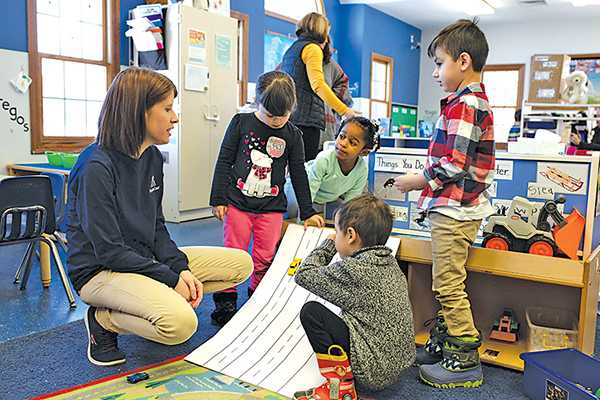Winter is the season for family gatherings, snow days and breaks from school and work, but all this time indoors can lead to a serious case of cabin fever for both children and adults. Before you face another chorus of “I’m bored,” consider these simple activities you and your child can do together when winter weather or schedules have you stuck indoors.
Each activity idea from the experts at KinderCare can help children build foundational skills they’ll need for success in STEM (science, technology, engineering and math) areas so you can combine fun and learning.
Infants
Most babies love sensory baskets, and it’s easy to make one at home. Fill a basket or low-sided container with materials in a variety of shapes, textures, weights, smells and sounds for your baby to explore. While your baby explores the materials and develops hand-eye coordination, describe what he or she is doing, seeing, feeling, hearing or tasting to help build his or her vocabulary.
Toddlers
Show your toddler how to make ramps by stacking blocks or small cardboard boxes and placing one edge of a piece of cardboard on top. Invite your child to gather toy vehicles or balls and other objects to see how they roll. Gather objects that will roll and a few that won’t. Encourage your child to ask questions and experiment with ramps of different heights. These experiments in force and motion can help develop your child’s understanding about how different objects behave on inclines.
Preschool (3-4-year-olds)
Invite your child to observe from a safe distance as you boil 1 cup red cabbage in 2 cups water. As the water turns purplish, drain it into a clear container. After the water cools, invite your child to measure a small amount of white vinegar and stir it in while observing what happens as additional vinegar is added. Next, have your child measure a small amount of baking soda or milk and stir it in to observe even more changes. Exploration, experimentation and observation are all key STEM skills.
Pre-Kindergarten (4-5-year-olds)
Gather a variety of craft items, building toys and recycled materials like construction paper, markers, pipe cleaners, craft sticks, fabric scraps, glue sticks, tape, scissors, blocks, interlocking toys, paper towel rolls, tissue boxes, cardboard, lids and plastic food containers. Place the materials you’ve gathered in a bag. Give your child the “tinker bag” and some space to build. Invite him or her to explore the materials, create something and share it with you as a way to build engineering skills and curiosity. Limiting the number of materials children have to work with can often create more opportunities for problem solving and innovation.
School Ages
Gather a few containers from your recycle bin, such as plastic food containers, tin cans or cracker boxes. Talk with your child about how some things typically thrown away or recycled can be reused for the same purpose or a new one. When items are reused, the amount of waste that ends up in landfills is reduced. Invite your child to select one of the containers and decide on a new use for it. When your child is finished creating something new using on-hand craft materials, ask him or her to share the innovation with you. Give your child feedback in the same way engineers do by giving a compliment, asking a question or offering a suggestion. (Family Features & KinderCare)





Leave a Comment
Your email address will not be published. Required fields are marked with *